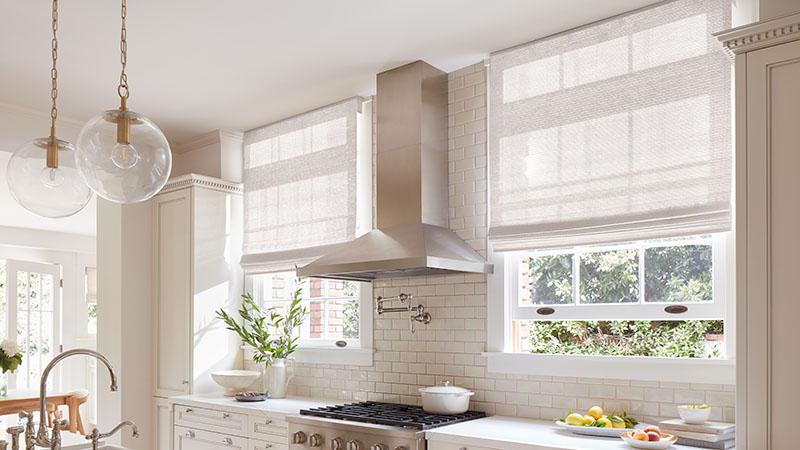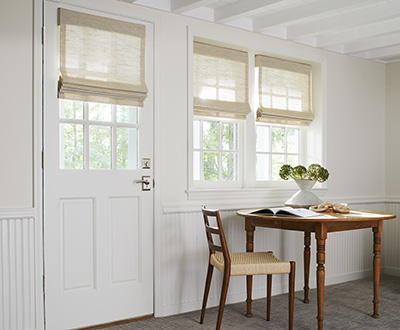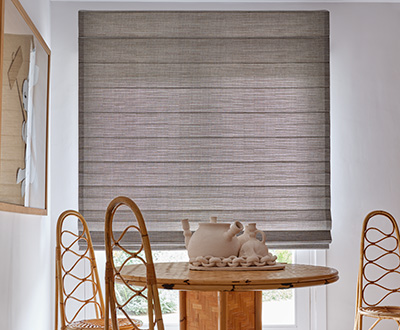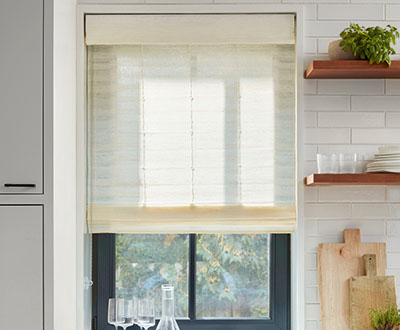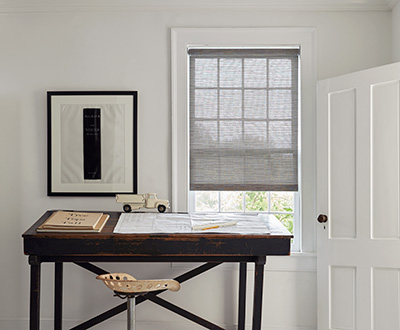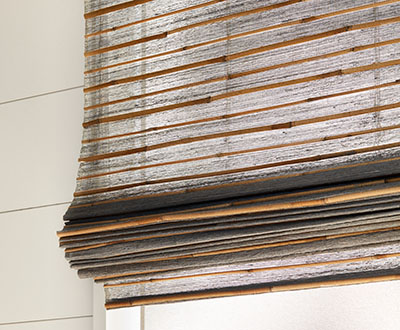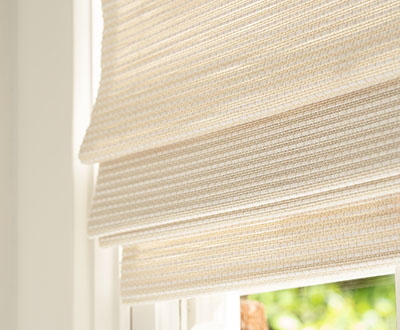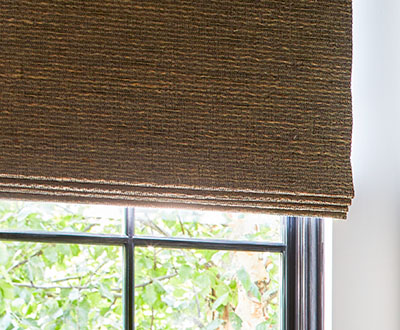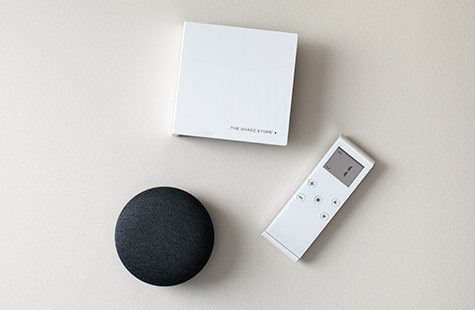BUYING GUIDE:Woven Wood Shades
Woven shades are an increasingly popular window treatment choice. Featuring natural textures thanks to their woven fibers, woven shades offer an invitingly simple, organic look that’s versatile enough to suit a wide range of aesthetic styles. But how do you know if Woven Wood Shades are the right fit for your space?
Our buying guide for woven shades for windows covers everything you need to know about this distinct window treatment, from style options to materials to control types and more.
Important
This buying guide covers all the details of Woven Wood Shades from The Shade Store. While some information will be universal to all Woven Shades, such as what they are, details like available styles, material options and install best practices will be specific to our Woven Wood Shades.
What Are Woven Wood Shades?
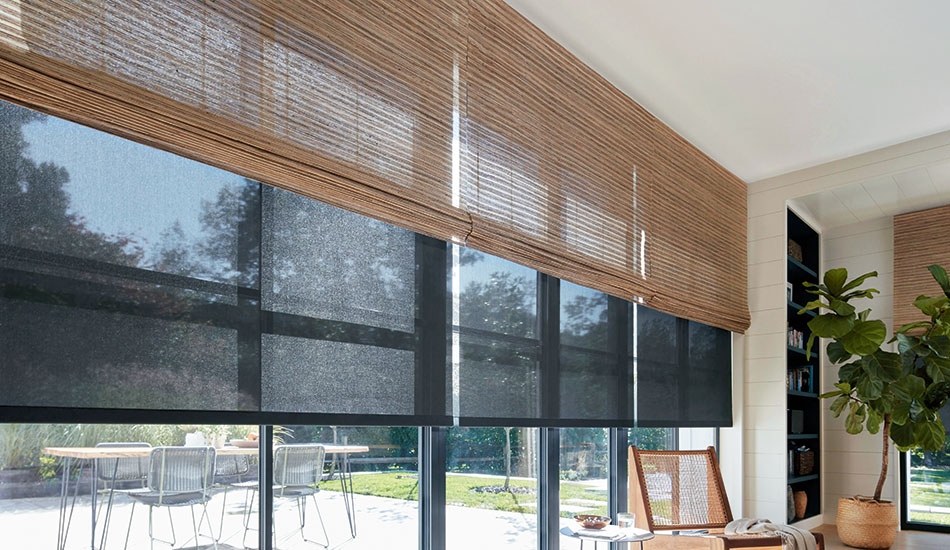
Woven window shades are a type of shade made from natural fibers such as bamboo, grasses, reeds or a mixture of fibers. The result is a shade with lots of visual and tactile texture as well as a rich organic aesthetic that brings the peaceful, relaxed ambiance of the outdoors, indoors.
Other Names for Woven Wood Shades
As you research Woven Wood Shades to determine if they’re the right window treatment for your space, you may have come across different terms used to describe the same type of shade.
Common terms used to describe Woven Wood Shades include:
- Woven Shades
- Woven Blinds
- Woven Window Shades
- Bamboo Shades
- Bamboo Blinds
All these terms refer to the same type of shade: One made from natural fibers woven together that’s either lifted and lowered by folding into crisp pleats or is rolled up or down around a roller tube.
At The Shade Store, we typically refer to them as Woven Wood Shades or woven shades, and we offer several different styles, lots of material options, and different control types. Learn about all your options for woven shades for windows to determine which style and customizations are best for you.
In this article
Why Choose Woven Shades for Windows
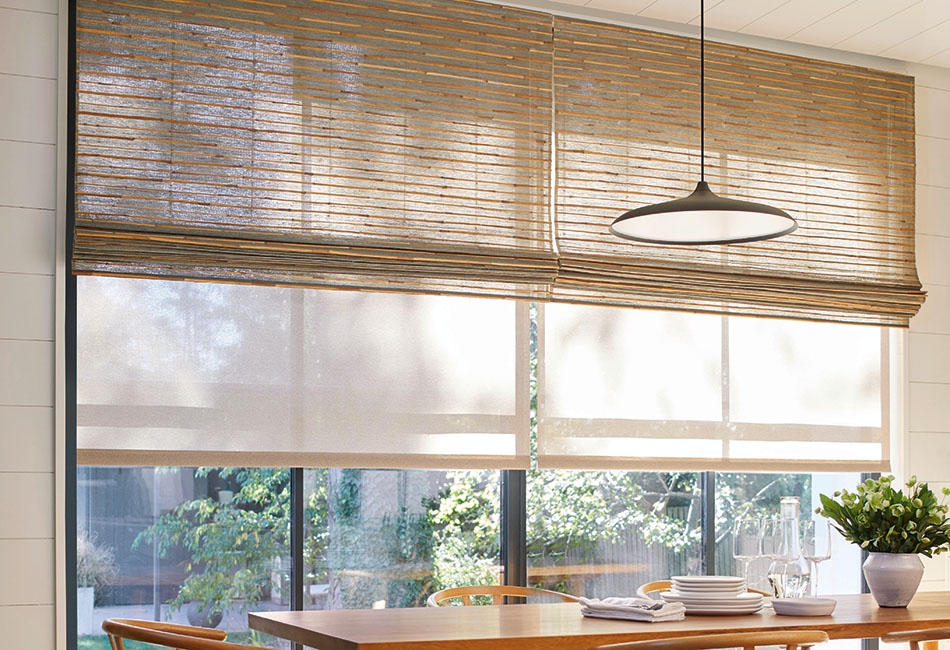
Woven shades for windows offer several unique benefits that make them an excellent, versatile choice for your home, including:
- Organic, natural beauty – These natural shades add a warm, organic beauty to any space.
- Lots of texture – Their woven fibers create texture in their look and feel which can add greater textural variety to your interior décor, increasing visual interest and design dimension.
- Functional – All styles of Woven Wood Shades are designed to be functional, whether you choose the basic continuous loop control system or upgraded controls like cordless or motorization.
- Eco-friendly – Our woven shades are made from bamboo, reeds and grasses that are all sustainably sourced so you can feel good about your choice.
Are Woven Wood Shades in Style?
The short answer? Yes. Woven Wood Shades are increasingly popular, especially thanks to the modern farmhouse movement sparked by Joanna Gaines, where warm wood tones and woven textures are a key design component. Learn more about window treatment trends and how woven shades fit into the trendy scene. EXPLORE TRENDS
Types of Woven Wood Shades
You know that woven shades for windows are in style and offer lots of benefits, but where do you go from here? Learn about the different styles of Woven Wood Shades. There are two main types of woven shades: those that are similar to certain Roman Shade styles and those that are similar to Roller Shades. Discover each type to determine which is best for you.
Materials for Woven Shades
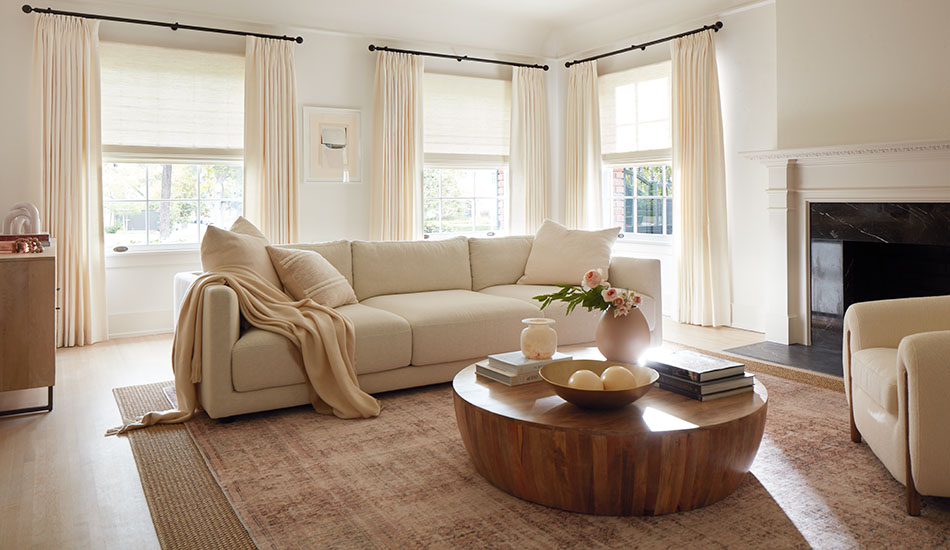
The material and color you choose for your shade is a defining factor of its overall aesthetic. When it comes to woven shades for windows, your material options all feature natural textures and wood-tone-inspired colors for an organic look. Choosing the right one for your home is all about the details: the texture created by the woven fibers and the undertones of the color. To start exploring materials, get familiar with the two main categories: Artisan Weaves and Naturals.
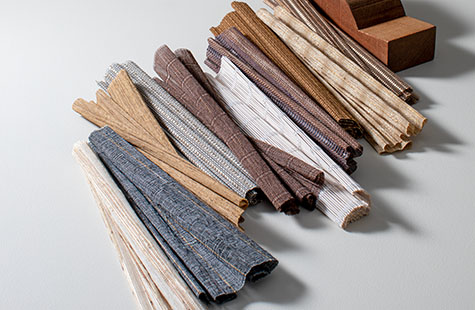
Artisan Weaves
The Artisan Weaves collection is made from all-natural materials like eco-friendly bamboo, grasses and reeds. Across the materials available, you’ll find different textures from coarse and rustic to smooth and soft, all with a hand-made, artisanal quality.
Artisan Weaves materials are only available for Waterfall and Standard styles of woven shades.
Naturals
Made from natural fibers like jute and paper mixed with synthetic materials like polyester, the Naturals collection offers a variety of woven textures and nature-inspired colors. Thanks to the incorporation of synthetic materials that help strengthen the fibers, the Naturals collection is available for all types of Woven Wood Shades, including Cascade and Roller Woven Shades.
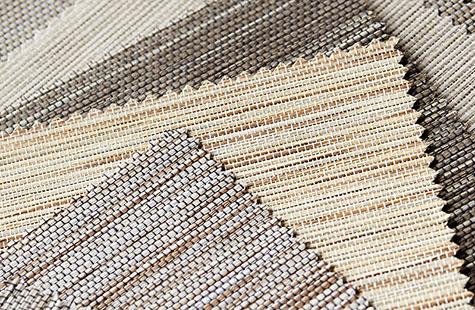
customize your design
Choose your style of Woven Wood Shade and start exploring your customization options to tailor your design to your specific wants and needs. START CUSTOMIZING
Achieve the Right Privacy & Light Control with Linings
Thanks to their woven fibers, woven shades will naturally filter light through their weaves for a soft, gentle glow and reduced glare. However, if you need greater light and privacy control, you have the option of adding lining to all types of woven shades for windows except Roller Woven Wood Shades.
Can You See Through Woven Wood Shades at Night?
In short, no you can’t quite see through woven shades at night. However, it may be possible to see silhouettes through the shade if you have your lights on. For the best privacy, line your shade with Privacy or Blackout lining.
Find the Right Functionality: Control Types
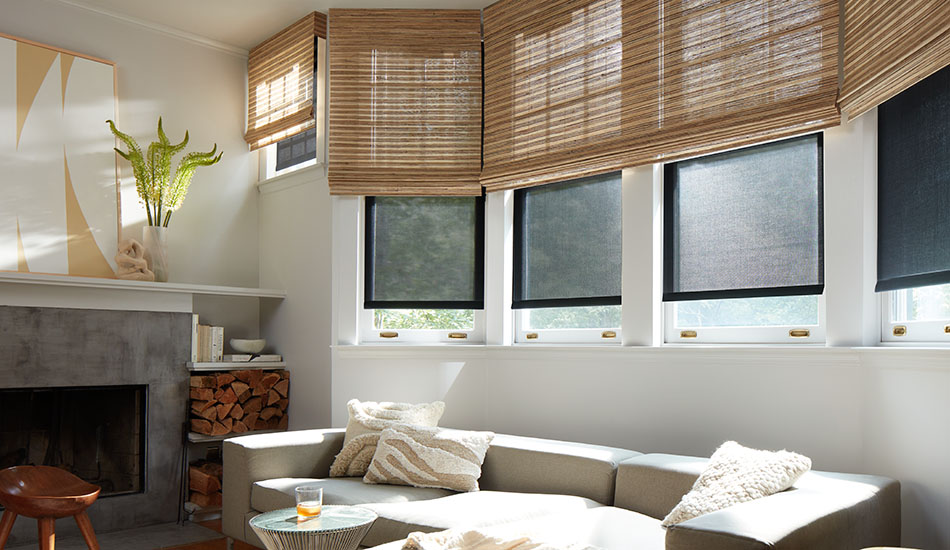
Control type refers to the mechanism used to open and close your woven shade. No matter which control type you choose, opening and closing your shade will be easy, but some control types are even more effortless than others.
Learn about your control type options, some of which may vary based on the style of Woven Wood Shade you choose, to get a feel for which might be best for your space.
Basic Control Type: Continuous Loop
The basic control, continuous loop is a common control and typically comes standard with your shade. It is very easy to use, but a little less streamlined in use and appearance than upgraded controls like cordless and motorization.
- Continuous Loop – This control type features a looped chain attached to the headrail and held taut by a tension device attached to the window frame or wall next to your window treatment. To lift or lower your shade, simply pull on one side of the chain. Continuous loop control is available for all types of Woven Wood Shades.
Cordless
Cordless woven shades offer easy functionality and a more streamlined look without any visible cords or strings. Cordless control works with a tension device in the headrail that controls the shade’s height. To use this type of control, simply pull on the ring just behind the bottom edge of your shade toward you to release the lock and pull the shade down or allow it to lift to adjust its height. Then, push the bottom of the shade back toward the window to lock it into place. Cordless control is available for Waterfall, Cascade and Roller Woven Shades for windows.
Motorized
For truly effortless functionality, consider motorized Woven Wood Shades. Motorized window treatments allow you to control the height of your shade with the press of a button on a remote, an app on your smart device or even the sound of your voice when paired with a home automation system. Motorization is available for all types of woven shades for windows.
*To pair your motor with a smart device, you’ll need our wireless link which converts the digital signal from your smart device into a radio signal that the motor understands.
Add Finishing Touches: Valances & Decorative Borders
Complete the look of your woven shades with additional customization options of valances and decorative borders. Keep in mind valances and decorative borders are only available for certain styles of Woven Wood Shades and certain materials.
Valances
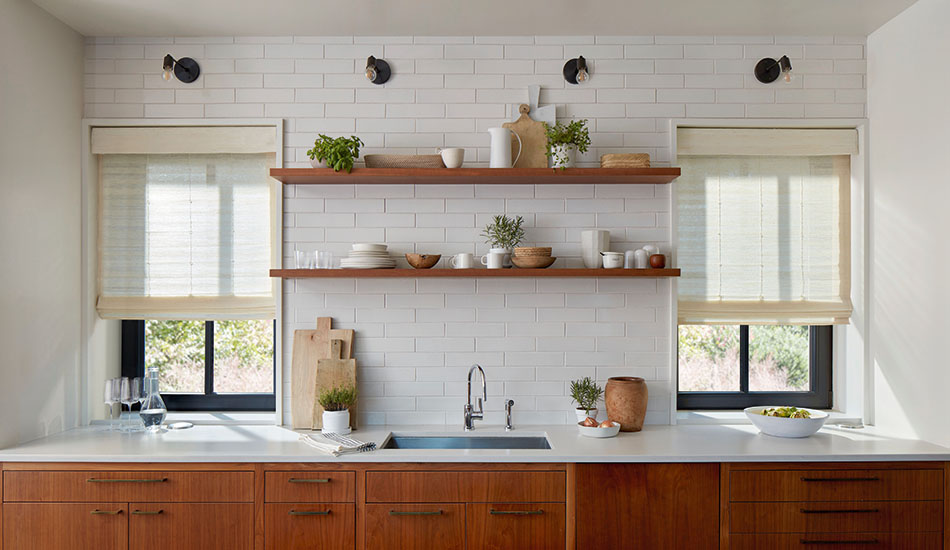
Valances are typically soft panels of material that hang over the top of your window treatment and help cover the headrail and any gaps created at the top of your window. However, there are also upholstered and metal valance options available for certain types of woven shades.
Keep in mind that Standard Woven Wood Shades always come with a valance to cover the headrail since the material falls off the back of the headrail, exposing it. For all other styles of woven shades for windows, you’ll have to ask to add a valance if you want one.
Valance options include:
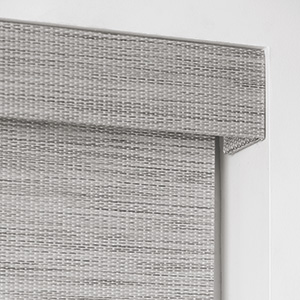
Upholstered Valance
An upholstered valance is a 4-inch handmade wood valance with material attached to it. Inside mount and outside mount options are available.
This type of valance is available for Standard, Waterfall, Cascade and Roller Woven Shades, but only when you choose a material from the Naturals collection.
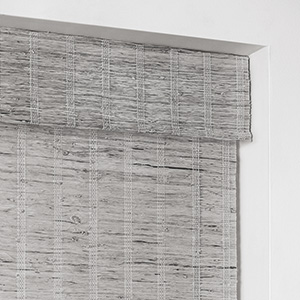
Soft Valance
A soft valance consists of a 6-inch section of matching fabric that falls in front of the headrail. Inside-mount and outside-mount options are available.
Soft valances is available for Standard and Waterfall Woven Shades, but only when you choose a material from the Artisan Weaves Collection.
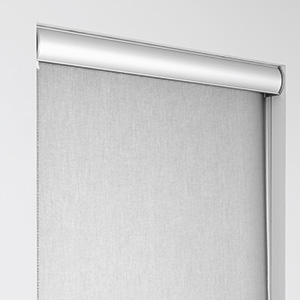
Metal Valance
Metal valances feature a curved piece of aluminum that covers the tube on Roller Woven Shades. Metal valances are available in five finishes, and you have the option to include a fabric insert to match the material of your shade.
This valance is available for regular roll Roller Woven Shades only.
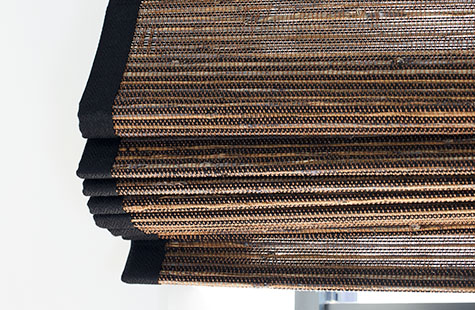
decorative borders
Decorative borders run along the outer edge of your shade, offering a defined, sophisticated aesthetic. Borders are available in several colors and are also made from woven material, so you maintain the all-natural, textured look you love. Choose a bold contrasting color for an emphasis on your shade’s silhouette or choose a subtle complementary color for a softer look. Decorative borders are only available for Waterfall, Standard and Cascade Woven Wood Shades.
discover curated designs
Visit our Photo Gallery for inspiring examples of natural Woven Wood Shades with various customizations in differently styled rooms to get a sense of your possibilities. VIEW THE GALLERY
Cost Considerations for Woven Shades
Now that you have an overview of all the styles, materials and customization options for Woven Wood Shades, you’re probably wondering what their cost is. The following chart shows a cost comparison of each style of woven shade at its starting price — meaning with basic customizations — without the additional price of installation.
| Type of Woven Wood Shade | Starting Price | |
|---|---|---|
| Waterfall Woven Wood Shades | 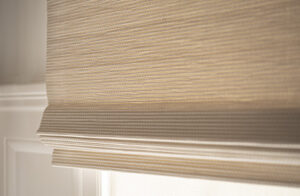 | $$$ |
| Standard Woven Wood Shades | 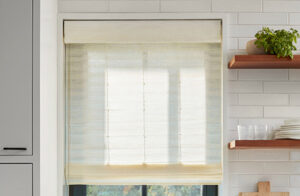 | $$$ |
| Cascade Woven Wood Shades | 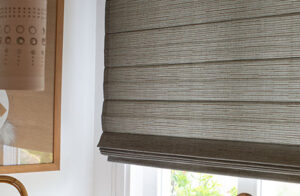 | $$$$ |
| Roller Woven Wood Shades | 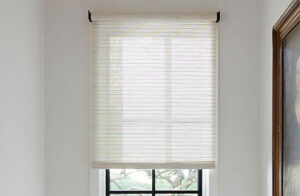 | $$ |
GET A QUICK PRICE QUOTE
Simply enter your measurements and get estimated pricing for different product categories and price groups. QUICK PRICE QUOTE
While having a sense of the basic starting price points for Woven Wood Shades is important, it’s also essential to understand how different customization factors affect your upfront cost.
Factors That Affect Upfront Costs
The starting price point for your woven shades will fluctuate based on the following factors:
- Size – The larger your shade, the more material is needed for it, and the greater the price is.
- Material – Some materials are higher quality than others, and so have a higher upfront cost.
- Control type – The basic control, continuous loop, will be less expensive than upgraded controls like cordless and motorization, with motorization being the most expensive option.
CUSTOMIZE YOUR WOVEN SHADES
Ready to start customizing your shades? Select your style, material, size, control type and more to create the ideal natural woven shade for your space.
Best Applications for Woven Wood Shades
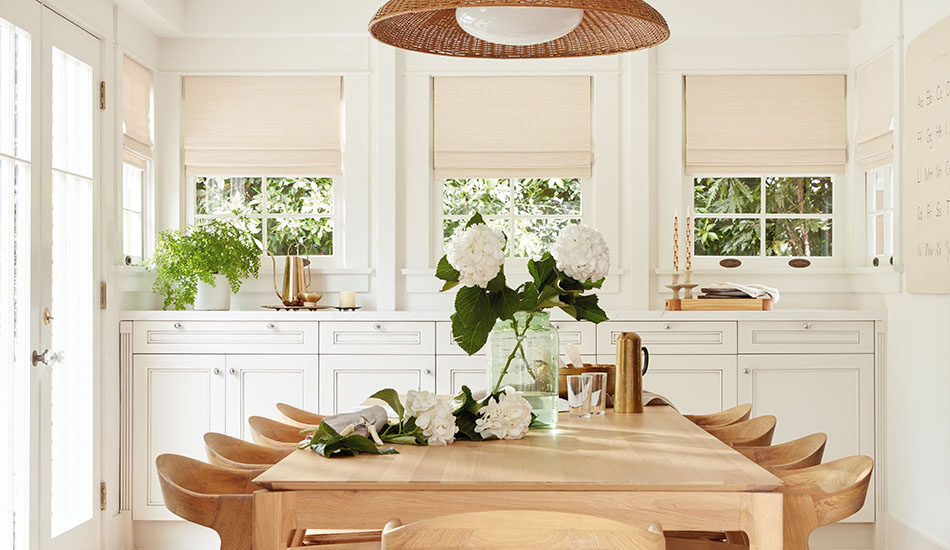
Woven Wood Shades are very versatile and suit a wide range of applications, with some being more suitable than others. Learn the best ways to incorporate woven shades for windows into your interior to help you decide which rooms they’ll best suit.
Inside- vs Outside-Mount Applications
Inside vs outside mount refers to where your shade is fastened in relation to the window frame.
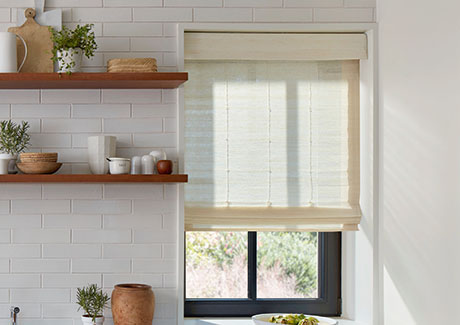
Inside Mount
Inside-mount applications refer to shades that are fastened inside the window box or frame from the “ceiling” of the box or from its sides.
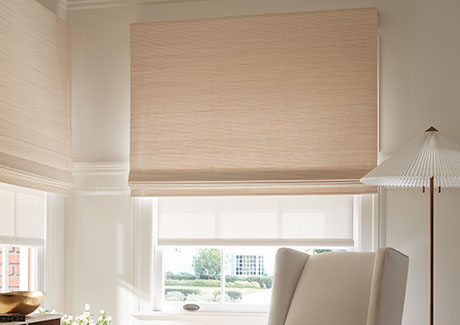
outside mount
Outside-mount applications refer to shades fastened outside the window frame, either on the wall above the frame or from the ceiling.
All types of woven shades for windows work great in either application, but keep in mind that for inside-mount applications, there is a depth requirement for the shade to be installed securely to the window frame. Depth requirements vary from ¾” to 1 ¾” depending on shade style, control type and material.
In addition to inside and outside mounts, the type of room you install your woven shades is also an important application to consider. Since Woven Wood Shades are made of natural materials, they are typically better suited to rooms without a lot of moisture or activity. Learn about what types of rooms are best suited to woven shades.
Rooms Best Suited to Woven Shades
- Living Rooms – Living rooms are a great place for Woven Wood Shades as they are typically free of excess moisture which can cause mold and mildew on your shades without proper cleaning or ventilation. Plus, since they are often used as gathering places for family and friends, they let you display your beautiful, natural woven shades regularly.
- Dining Rooms – Dining rooms are another gathering place with a bit more formality, making them a great place to display you woven shades. Moisture is also typically minimal in dining rooms, so there’s no worry about mold or mildew.
- Bedrooms – Thanks to privacy and blackout linings, you can achieve a tranquil, private oasis in your bedrooms with Woven Wood Shades.
Rooms Woven Shades Can Work In
- Kitchens – While kitchens can have a lot of food splattering and moisture in the air, as long as your shades are always drawn up away from the sink, counter or stove where you’re working, you shouldn’t have any issues with mold, mildew or stains.
Rooms Not Ideal for Woven Shades
- Basements – Basements are often humid, dark and cool, which is the perfect environment for mold and mildew growth, especially on natural woven shades, which these fungi can feed off of. Instead of woven shades, consider Roman Shades made from synthetic materials like Sunbrella.
- Bathrooms – Bathrooms also have a lot of moisture, making them not ideal for natural woven shades. Instead, try Metal Blinds, Roller Shades or Solar Shades.
With lots of insight into your Woven Wood Shade customization options as well as where they work best, it’s time to learn how to measure so you can start the ordering process.
How to Measure for Woven Shades
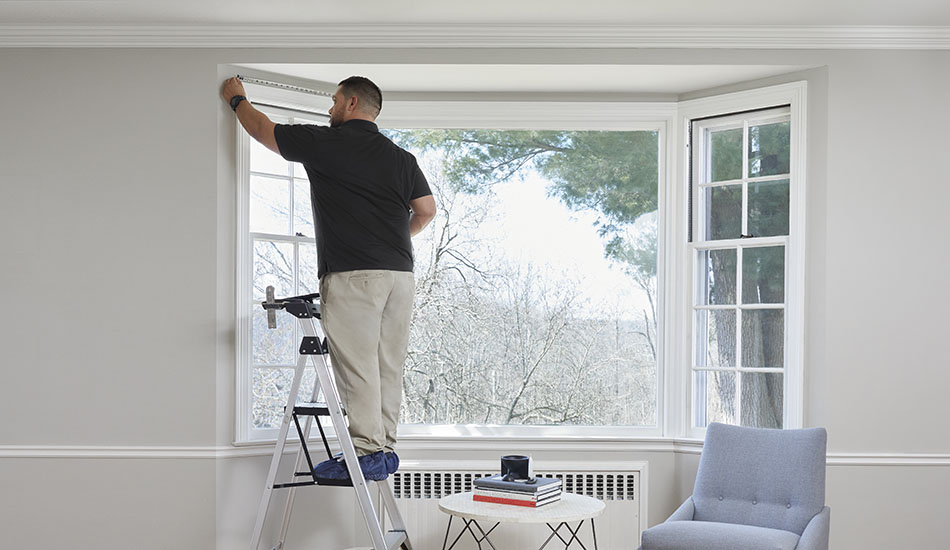
Measuring for woven shades is similar to other types of shades, and primarily depends on whether you’ll install your shades in an inside- or outside-mount application. There’s also a slightly different process for measuring for Roller Woven Shades:
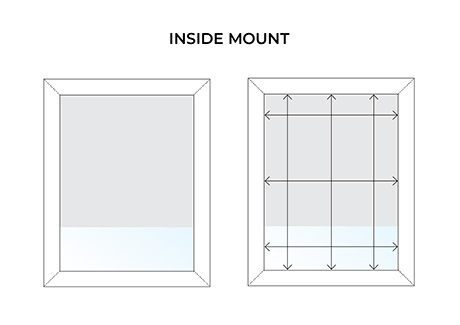
Measuring for Inside Mount
To calculate your measurements for an inside-mount application, follow these steps:
Step 1: Measure the depth of your window frame (from the glass to the edge of the window’s interior trim) to ensure you have the appropriate depth requirement (at least ¾”).
Step 2: Take three measurements for length (from the right, middle and left of the frame) and use the largest number as your order length.
Step 3: Take three measurements (from the top, middle and bottom of the frame) and use the smallest number for your ordering width.
For Roller Woven Shades, take three measurements for length, but only one measurement for width: At the top of your frame, since that’s where a Roller Shade is widest.
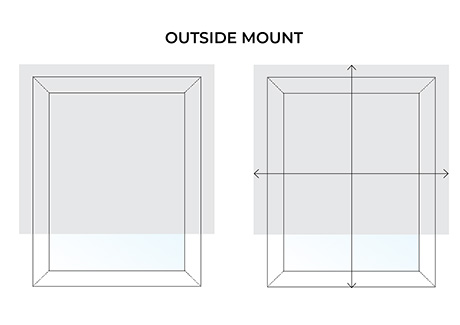
Measuring for Outside Mount
The process for measuring for an outside-mount application is very simple. Plus, it’s universal between all types of woven shades for windows, including Roller Woven Shades.
To measure for an outside mount, follow these steps:
Step 1: To measure width, measure the entire distance you want your shade to cover beyond the window frame on either side, making sure the shade extends the same distance on each side of the frame.
Step 2: To measure for length, start at the point above your window frame where you want the headrail to be installed. If you’re installing it on the ceiling, start at the ceiling. Then measure down just past the window frame. This is your ordering length, based on how far you want your shade to extend above the window frame.
Installation Best Practices
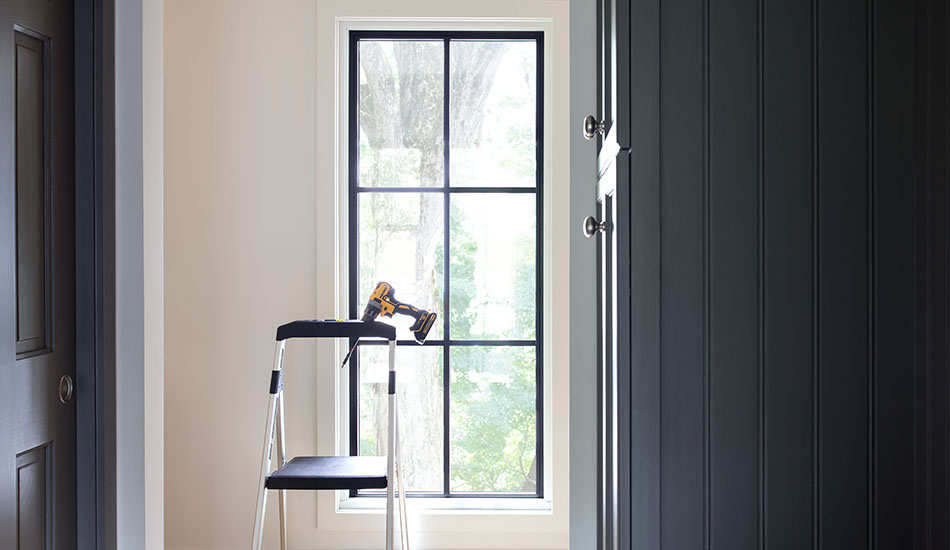
Installing Woven Wood Shades will vary a bit based on the type of shade you’ve chosen and the application (inside vs outside mount). Follow these general best practices to help you determine if a DIY project is right for you.
Leave It to the Professionals
When you choose Woven Wood Shades from The Shade Store, you’ll enjoy a free professional measurement, plus, we’ll come back for installation (install fees apply). Start your project off with a free measurement.
Install Best Practices: Waterfall, Cascade & Standard Styles
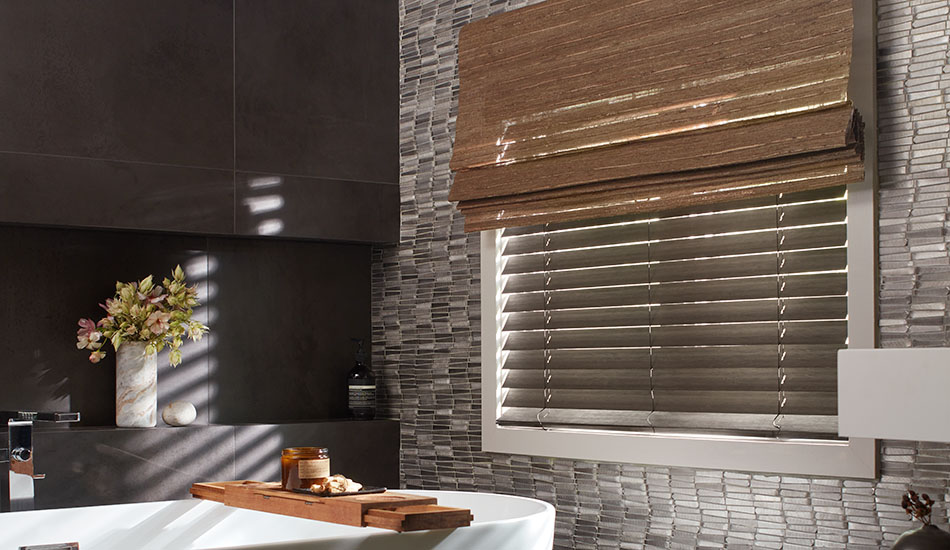
The following steps are the best installation practices for Waterfall, Cascade and Standard Style Woven Wood Shades.
- Step 1: Gather tools. You’ll likely need a stepladder, pencil, tape measure, level, drill and a screwdriver.
- Step 2: For an inside-mount, first take the screws and start fastening them into the mounting holes of the headrail until the tip of the screw is showing on the top of the headrail. Then, hold the shade, centered, inside the window frame and push up so that the screw tips leave indentations in the window frame. For an outside-mount, you’ll need to mark where the mounting brackets will be placed on your wall or ceiling. To do this, hold your shade at the desired height above the window and center it. You’ll see slot holes in the top of the headrail — place pencil marks in the center of the slot holes, as this is where your mounting brackets will be placed.
- Step 3: Drill pilot holes into the marks made in Step 2. This can be done for both inside- and outside-mount applications.
- Step 4: For inside mount, reposition the headrail, ensuring the screws are aligned with the pre-drilled holes. Fasten the screws securely. For outside mount, center the brackets on the holes made in Step 3 and fasten them. With the brackets installed, check they are level. Then, remove the wingnuts on the long screw and slide the headrail slots on the screws. Reattach the wingnuts by hand to secure the shade.
Install Best Practices: Roller Woven Shades
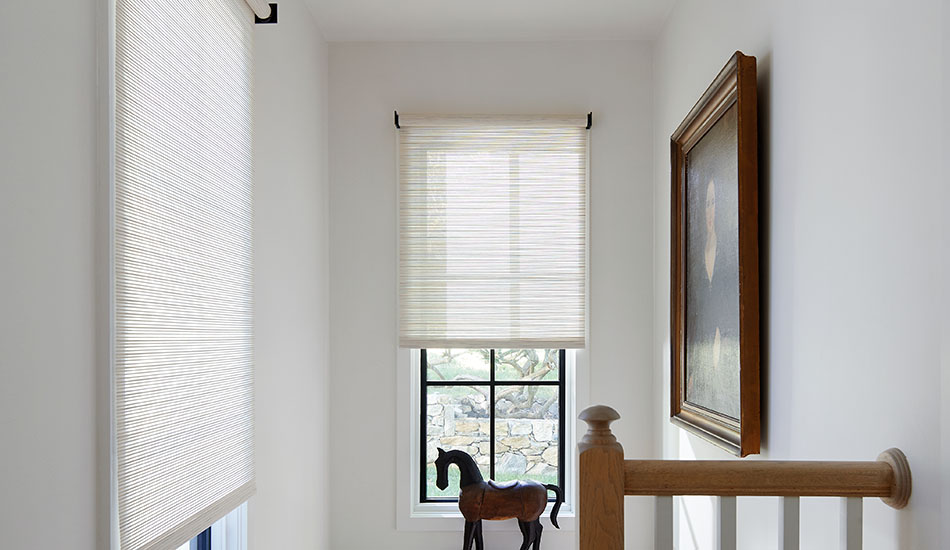
Since Roller Woven Shades are a completely different style than the other types of Woven Wood Shades, they have different install best practices:
- Step 1: Gather tools. You’ll likely need a stepladder, pencil, tape measure, level, drill and a screwdriver.
- Step 2: Mark where the mounting brackets and tube will go based on your measurements and mounting application (inside or outside mount).
- Step 3: Install the brackets over the marks made in Step 2 with the appropriate tools as indicated in the installation guide.
- Step 4: Attach the tube in either a regular roll (where the material falls off the back of the tube) or a reverse roll (where the material falls off the front of the tube).
Cleaning & Maintenance for Woven Shades
To ensure your Woven Wood Shades remain beautiful and functional, it’s important to care for them properly. To keep them clean, use a low-suction, handheld vacuum regularly. Or dust them with a soft, clean cloth or feather duster.
For dirt or stain removal, you can try a household cleaner, but always test it on a swatch first to ensure it interacts well with the material. For best results, however, we recommend contacting a local window treatment cleaning specialist who can treat your shade onsite typically without even taking it down.
Frequently Asked Questions About Woven Shades
Review the following frequently asked questions for an even deeper understanding of Woven Wood Shades.
SHOP WOVEN WOOD SHADES
See your product options and make the right selections to design the perfect Woven Wood Shades for your home.
